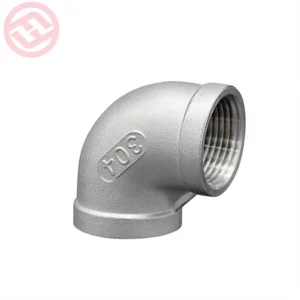The corrosion resistance of stainless pipe fittings offers several benefits in different environments:
- Resistance to general corrosion: Stainless steel pipe fittings, due to their high chromium content, exhibit excellent resistance to general corrosion. They are highly resistant to rust, oxidation, and staining, making them suitable for use in environments where exposure to moisture, chemicals, or corrosive substances is common.
- Resistance to pitting corrosion: Pitting corrosion is a localized form of corrosion that can occur in the presence of chloride ions or other aggressive substances. Stainless pipe fittings, particularly those made from austenitic stainless steel grades like 304 and 316, have a high resistance to pitting corrosion. This makes them ideal for applications in marine environments, coastal areas, and industrial settings where exposure to chlorides or saline solutions is prevalent.
- Resistance to crevice corrosion: Crevice corrosion occurs in narrow gaps or crevices where stagnant water or corrosive substances can accumulate. Stainless pipe fittings, with their inherent corrosion resistance, are less prone to crevice corrosion compared to other materials. This quality makes them suitable for applications in piping systems with tight spaces, such as heat exchangers, chemical reactors, and sanitary systems.
- Acid resistance: Stainless pipe fittings are highly resistant to various acids, including organic acids, mineral acids, and weak acids. This property is beneficial in industries such as chemical processing, pharmaceuticals, and food and beverage, where the conveyance of corrosive acids is common.
- Alkali resistance: Stainless pipe fittings also exhibit good resistance to alkalis, including strong alkaline solutions. This resistance makes them suitable for use in applications involving cleaning agents, caustic solutions, and alkaline environments.
- High-temperature resistance: Certain stainless steel grades, such as the austenitic stainless steels, maintain their corrosion resistance even at high temperatures. This property allows stainless pipe fittings to be used in high-temperature applications, such as heat exchangers, steam systems, and exhaust systems.
- Longevity and durability: The corrosion resistance of stainless pipe fittings contributes to their longevity and durability. They have a longer service life compared to other materials, reducing the need for frequent replacements and maintenance.
Overall, the corrosion resistance of stainless pipe fittings ensures the integrity and reliability of piping systems in a wide range of environments, including corrosive, high-moisture, and high-temperature conditions.
What are the standards or codes that govern the manufacturing and use of stainless pipe fittings?
The manufacturing and use of stainless pipe fittings are governed by various standards and codes to ensure quality, safety, and compatibility.
Here are some commonly referenced standards and codes:
- ASTM (American Society for Testing and Materials): ASTM has established several standards for stainless steel pipe fittings, including material specifications, dimensions, and testing methods. ASTM A403 covers wrought austenitic stainless steel pipe fittings, while ASTM A774 specifies the requirements for fabricated fittings.
- ASME (American Society of Mechanical Engineers): ASME standards are widely used in the design, fabrication, and installation of stainless pipe fittings. The ASME B16 series of standards, such as B16.9 for factory-made wrought steel butt-welding fittings and B16.11 for forged steel fittings, provide guidelines for dimensions, tolerances, and materials.
- ANSI (American National Standards Institute): ANSI develops and publishes standards that define the requirements for stainless pipe fittings in terms of dimensions, materials, and performance. ANSI/ASME B1.20.1 covers pipe threads, while ANSI/ASME B16.5 provides specifications for flanges.
- MSS (Manufacturers Standardization Society): MSS develops and publishes standards for various pipe fittings, including stainless steel fittings. Stainless Pipe Fitting The MSS SP-43 standard covers wrought and fabricated butt-welding fittings, while MSS SP-97 specifies integrally reinforced forged branch outlet fittings (olets).
- ISO (International Organization for Standardization): ISO standards also play a role in the manufacturing and use of stainless pipe fittings. ISO 4144 provides specifications for stainless steel fittings for general purposes, and ISO 9001 sets quality management system requirements for manufacturers.
- API (American Petroleum Institute): API standards are relevant to stainless pipe fittings used in the oil and gas industry. API 6A specifies requirements for wellhead and Christmas tree equipment, including fittings, while API 602 covers compact steel gate valves that may include stainless steel components.
Additionally, regional or industry-specific codes and regulations may apply depending on the location and application. For example, in the United States, the National Fire Protection Association (NFPA) publishes codes and standards related to fire protection systems, including stainless pipe fittings used in sprinkler systems.
It is important to consult the appropriate standards and codes relevant to your specific application and jurisdiction to ensure compliance and the safe and reliable use of stainless pipe fittings.
